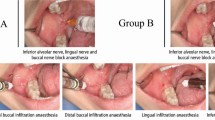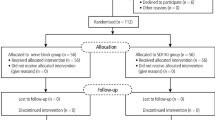Abstract
Aims To compare the anaesthetic efficacy of articaine, lidocaine and mepivacaine for buccal infiltration (BI) following lidocaine inferior alveolar nerve block (IANB) in mandibular posterior teeth with irreversible pulpitis.
Materials and methods Patients with irreversible pulpitis in mandibular posterior teeth and unsuccessful IANB were randomly assigned to three groups: articaine group (n = 52), lidocaine group (n = 52) and mepivacaine group (n = 52). They were instructed to rate the pain experienced at four phases (before the injection, after IANB, after BI and during endodontic access) on a Heft-Parker visual analogue scale (VAS). Success was defined as the ability to access and instrument the tooth with no pain or mild pain (VAS rating ≤54 mm) after BI.
Results Multivariate logistic regression analysis showed that articaine was associated with a higher success rate compared with lidocaine (OR = 3.89, 95% CI: 1.35-11.27; P = 0.02) and mepivacaine (OR = 3.67, 95% CI: 1.24-9.75; P = 0.01), after controlling for age, gender and initial pain. VAS ratings were significantly lower in the articaine group compared with those in the lidocaine group and mepivacaine group after BI and during endodontic access (P <0.01).
Conclusion Articaine as a supplemental BI following IANB is a more successful anaesthetic agent in mandibular posterior teeth with irreversible pulpitis compared with lidocaine and mepivacaine.
This is a preview of subscription content, access via your institution
Access options
Subscribe to this journal
Receive 24 print issues and online access
$259.00 per year
only $10.79 per issue
Buy this article
- Purchase on Springer Link
- Instant access to full article PDF
Prices may be subject to local taxes which are calculated during checkout


Similar content being viewed by others
References
Dou L, Vanschaayk M M, Zhang Y, Fu X, Ji P, Yang D. The prevalence of dental anxiety and its association with pain and other variables among adult patients with irreversible pulpitis. BMC Oral Health 2018; 18: 101.
Peretz B, Moshonov J. Dental anxiety among patients undergoing endodontic treatment. J Endod 1998; 24: 435-437.
Claffey E, Reader A, Nusstein J, Beck M, Weaver J. Anaesthetic efficacy of articaine for inferior alveolar nerve blocks in patients with irreversible pulpitis. J Endod 2004; 30: 568-571.
Nagendrababu V, Pulikkotil S J, Suresh A, Veettil S K, Bhatia S, Setzer F C. Efficacy of local anaesthetic solutions on the success of inferior alveolar nerve block in patients with irreversible pulpitis: a systematic review and network meta-analysis of randomized clinical trials. Int Endod J 2019; 52: 779-789.
Matthews R, Drum M, Reader A, Nusstein J, Beck M. Articaine for supplemental buccal mandibular infiltration anaesthesia in patients with irreversible pulpitis when the inferior alveolar nerve block fails. J Endod 2009; 35: 343-346.
Gaffen A S, Haas D A. Survey of local anaesthetic use by Ontario dentists. J Can Dent Assoc 2009; 75: 649.
da Silva-Junior G P, de Almeida Souza L M, Groppo F C. Comparison of Articaine and Lidocaine for Buccal Infiltration After Inferior Alveolar Nerve Block For Intraoperative Pain Control During Impacted Mandibular Third Molar Surgery. Anesth Prog 2017; 64: 80-84.
Rogers B S, Botero T M, McDonald N J, Gardner R J, Peters M C. Efficacy of articaine versus lidocaine as a supplemental buccal infiltration in mandibular molars with irreversible pulpitis: a prospective, randomized, double-blind study. J Endod 2014; 40: 753-758.
Shapiro M R, McDonald N J, Gardner R J, Peters M C, Botero T M. Efficacy of Articaine versus Lidocaine in Supplemental Infiltration for Mandibular First versus Second Molars with Irreversible Pulpitis: A Prospective, Randomized, Double-blind Clinical Trial. J Endod 2018; 44: 523-528.
Heft M W, Parker S R. An experimental basis for revising the graphic rating scale for pain. Pain 1984; 19: 153-161.
Malamed S. Handbook of Local Anaesthesia. St. Louis: Mosby, 2007.
Bartlett G, Mansoor J. Articaine buccal infiltration vs lidocaine inferior dental block - a review of the literature. Br Dent J 2016; 220: 117-120.
Monteiro M R, Groppo F C, Haiter-Neto F, Volpato M C, Almeida J F. 4% articaine buccal infiltration versus 2% lidocaine inferior alveolar nerve block for emergency root canal treatment in mandibular molars with irreversible pulpits: a randomized clinical study. Int Endod J 2015; 48: 145-152.
Renton T. Optimal Local Anaesthesia for Dentistry. Prim Dent J 2019; 7: 51-61.
Kanaa M D, Whitworth J M, Meechan J G. A prospective randomized trial of different supplementary local anaesthetic techniques after failure of inferior alveolar nerve block in patients with irreversible pulpitis in mandibular teeth. J Endod 2012; 38: 421-425.
Jayasuriya N S S, Jayasundara J H, Pallegama R W. Efficacy of buccal infiltration anaesthesia with articaine for extraction of mandibular molars: a clinical trial. Br J Oral Maxillofac Surg 2019; 57: 296-297.
Hosseini H R, Parirokh M, Nakhaee N, V Abbott P, Samani S. Efficacy of Articaine and Lidocaine for Buccal Infiltration of First Maxillary Molars with Symptomatic Irreversible Pulpitis: A Randomized Double-blinded Clinical Trial. Iran Endod J 2016; 11: 79-84.
Gazal G, Alharbi A M, Al-Samadani K H, Kanaa M D. Articaine and mepivacaine buccal infiltration in securing mandibular first molar pulp anaesthesia following mepivacaine inferior alveolar nerve block: A randomized, double-blind crossover study. Saudi J Anaesth 2015; 9: 397-403.
Chitre A P. Manual of Local Anaesthesia in Dentistry. New Delhi: Jaypee Brothers Medical Publishers, 2016.
Subramaniam K, Dhanraj M, Jain A. Effectiveness of intraligamental anaesthesia in controlling the hyperesthesia during tooth preparation. Drug Invent Today 2018; 10: 1020-1023.
Nydegger B, Nusstein J, Reader A, Drum M, Beck M. Anaesthetic comparisons of 4% concentrations of articaine, lidocaine, and prilocaine as primary buccal infiltrations of the mandibular first molar: a prospective randomized, double-blind study. J Endod 2014; 40: 1912-1916.
Skjevik A A, Haug B E, Lygre H, Teigen K. Intramolecular hydrogen bonding in articaine can be related to superior bone tissue penetration: a molecular dynamics study. Biophys Chem 2011; 154: 18-25.
Kuhn B, Mohr P, Stahl M. Intramolecular hydrogen bonding in medicinal chemistry. J Med Chem 2010; 53: 2601-2611.
Author information
Authors and Affiliations
Corresponding author
Rights and permissions
About this article
Cite this article
Gao, X., Meng, K. Comparison of articaine, lidocaine and mepivacaine for buccal infiltration after inferior alveolar nerve block in mandibular posterior teeth with irreversible pulpitis. Br Dent J 228, 605–608 (2020). https://doi.org/10.1038/s41415-020-1434-9
Published:
Issue Date:
DOI: https://doi.org/10.1038/s41415-020-1434-9
This article is cited by
-
Efficacy of analgesia promoted by lidocaine and articaine in third molar extraction surgery. A split-mouth, randomized, controlled trial
Oral and Maxillofacial Surgery (2024)
-
Biological evaluation of the efficacy of two different anesthetic solutions in pain control during extraction of mandibular second primary molars
Bulletin of the National Research Centre (2022)
-
Articaine in dentistry: an overview of the evidence and meta-analysis of the latest randomised controlled trials on articaine safety and efficacy compared to lidocaine for routine dental treatment
BDJ Open (2021)



